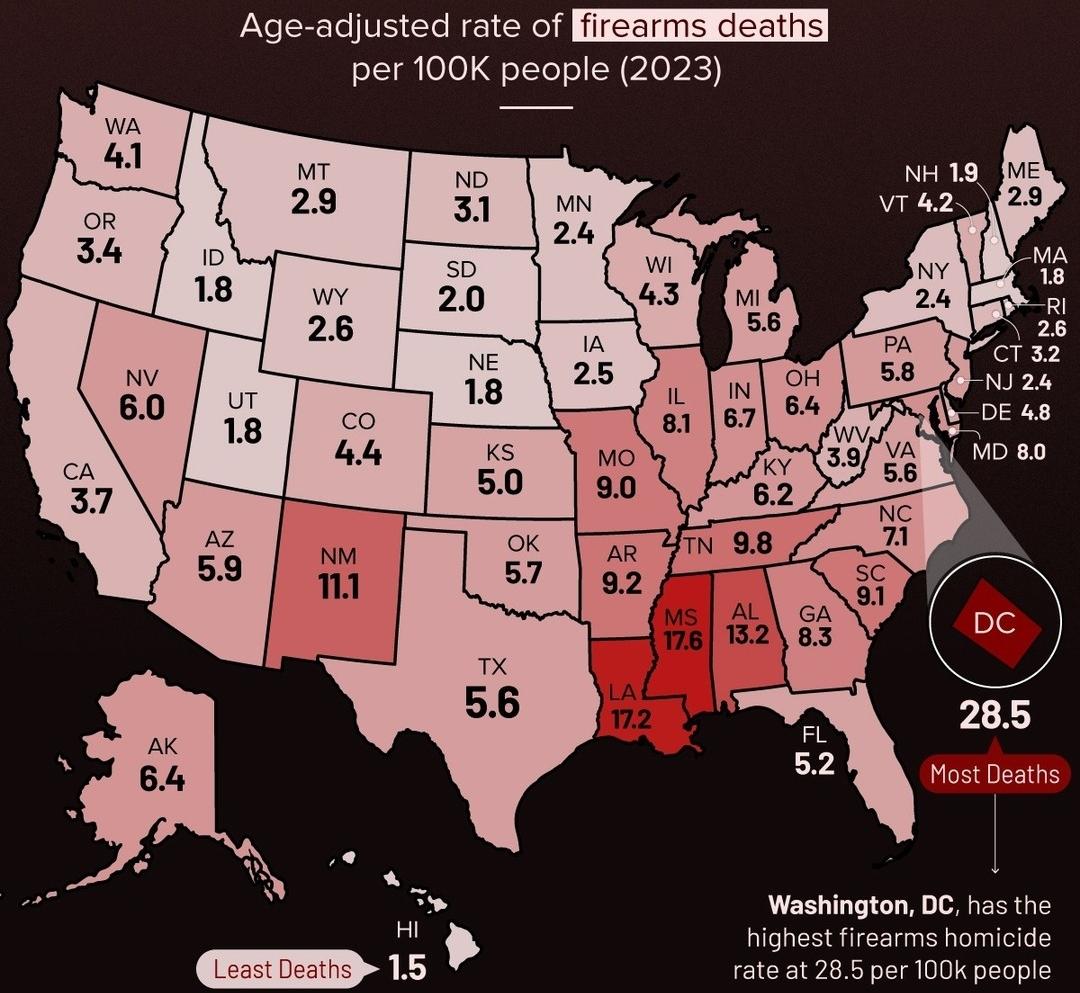Gun Related Deaths in the USA Map


David Chen
Data Visualization Specialist
David Chen is an expert in transforming complex geographic datasets into compelling visual narratives. He combines his background in computer science ...
Geographic Analysis
What This Map Shows
The "Gun Related Deaths in the USA Map" provides a stark visual representation of the incidence of firearm-related fatalities across the United States. This map highlights the disparities in gun-related deaths by state, allowing viewers to quickly identify regions with the highest and lowest rates. From urban centers to rural areas, the visualization underscores the complex landscape of gun violence in America.
Transitioning from the visualization, it's essential to delve deeper into the subject of gun-related deaths. Understanding the patterns and factors contributing to these fatalities is crucial for addressing the issues surrounding gun violence in the country.
Deep Dive into Gun Related Deaths
Gun-related deaths encompass a range of incidents, including homicides, suicides, and unintentional shootings. In recent years, discussions around gun violence have intensified, particularly in light of mass shootings and the ongoing debate over gun control legislation. Interestingly, the majority of gun-related deaths in the United States are suicides, accounting for nearly two-thirds of all firearm fatalities. This statistic highlights a critical aspect of the issue, as mental health plays a significant role in these tragic outcomes.
The data shows that states with higher rates of gun ownership often correlate with increased gun-related death rates. For instance, states like Louisiana and Alaska report significantly higher numbers of gun deaths compared to states with stricter gun control laws, such as New York and New Jersey. This correlation raises important questions about the effectiveness of gun legislation and the cultural attitudes toward firearms in different regions.
Moreover, urban areas typically report higher homicide rates involving firearms, while rural regions may see a greater prevalence of suicides. For example, cities like Chicago and Baltimore are often highlighted in discussions of gun violence due to their high homicide rates. In contrast, states like Montana and Wyoming, although less populated, experience a higher proportion of suicides involving firearms, reflecting the unique challenges faced in those areas.
Understanding these nuances is crucial for developing targeted interventions. What’s fascinating is that regions with robust community support programs and mental health resources often report lower rates of gun-related deaths, suggesting that proactive measures can make a difference.
Regional Analysis
When analyzing the map, distinct patterns emerge across different regions of the United States. The South, for instance, consistently shows higher rates of gun-related deaths. States like Alabama and Mississippi report alarming figures, with gun violence often intertwined with socioeconomic factors such as poverty and lack of access to education.
Conversely, the Northeast, particularly states like Massachusetts and Connecticut, tends to have lower rates of gun-related deaths. This difference can be attributed to stricter gun laws and public health initiatives aimed at reducing violence. Interestingly, California, with its large population, has managed to maintain a relatively lower rate of gun deaths compared to states with similar demographics, thanks to comprehensive gun control measures.
Furthermore, the Midwest presents a mixed picture. States like Illinois, with urban centers facing significant gun violence, contrast with their rural counterparts, where the focus may shift more toward suicides. This regional analysis shows that while some states grapple with gun violence as a public safety crisis, others face challenges related to mental health and access to care.
Significance and Impact
Why does understanding gun-related deaths matter? The implications of this topic extend far beyond statistics; they touch on public health, safety, and policy-making. Addressing gun violence is not merely about enforcing laws; it requires a multifaceted approach that includes mental health support, community engagement, and addressing root causes of violence.
As we look to the future, trends indicate that without effective intervention, gun-related deaths may continue to rise. Recent discussions around gun control legislation, especially in the wake of high-profile shootings, have sparked renewed interest in finding solutions. However, the polarization of opinions on this issue often complicates efforts for meaningful change.
As a society, we must ask ourselves: how can we balance the rights of individuals to own firearms with the need to protect our communities? The answer lies in comprehensive strategies that address both the cultural and systemic factors contributing to gun violence.
In conclusion, while the "Gun Related Deaths in the USA Map" serves as a powerful visual tool, it is the conversation surrounding gun violence that truly matters. By understanding the complexities and regional disparities, we can work toward a safer future for all.
Visualization Details
- Published
- October 24, 2025
- Views
- 10
Comments
Loading comments...